The long-standing problem of optimising truck capacity is one many digital logistics players are vying to address, each one of which have their own take on how to best approach the challenge. Among them is CtrlChain, an innovative Dutch digital logistics solution provider which has been growing at a fast pace since its foundation in September 2018.

The company, founded by Giovanni Gubbels and his co-founders Jeroen Kemp and Coen van Boxtel, has embarked on several initiatives in recent years to revolutionize the transportation industry through a sustainable and technology-oriented approach.
CtrlChain leverages cutting-edge technologies, including machine learning and data analytics, to make well-informed decisions and implement strategies that improve efficiency and sustainability.
Moreover, CtrlChain is among a group of participants in the digital logistics sector who no longer perceive themselves solely as digital forwarders but encompass a broader role.
To gain insights into these advancements and more, we interviewed CEO & founder Giovanni Gubbels to discuss the optimal solution for addressing the truck capacity issue, the projected market trends, the investor landscape, and the future of data sharing, among other topics.
Thanks for talking to us Giovanni. In recent months I’ve come across a couple of companies who were once very much considered digital forwarders. They now either see themselves as something different or something more. Something similar seems to be happening in your case? Why might digital logistics companies be de-associating themselves with digital forwarding to an extent?
Well, let’s go back to why we started CtrlChain. Our main motivation is to make a positive change in sustainability, climate change, and all environmental aspects. Our mission revolves around optimising resource utilisation on the roads. Once you delve into it, the primary challenge lies in the lack of visibility regarding availability and the inability to plan effectively even when capacity exists at a given moment.
We believe the path to overcoming this challenge lies in digitalisation. By digitising these processes and harnessing the data, we can make more informed decisions. Our main focus is on the carrier side of operations, where we provide carriers with a range of complimentary services and software solutions. This approach enables us to effectively utilise the data they generate to optimise their operations and planning. As a result, the carriers will become more efficient and profitable while driving fewer kilometres empty, resulting in less unnecessary CO2 emissions.
While our sustainability efforts sound impressive, they don’t directly bring any revenue. To achieve our goals, we aim to position ourselves as an all-in-one logistics partner for shippers, managing all aspects related to goods transportation.
Together we can measure various metrics and make necessary adjustments to drive improvements. This extends not only to carrier performance but also to optimising backload and delivery destinations, all based on the information our system can process and learn from.
I see you opened an office in Chicago at the start of the year. What was the thinking behind that, and what differences have you noticed between the US and European markets?
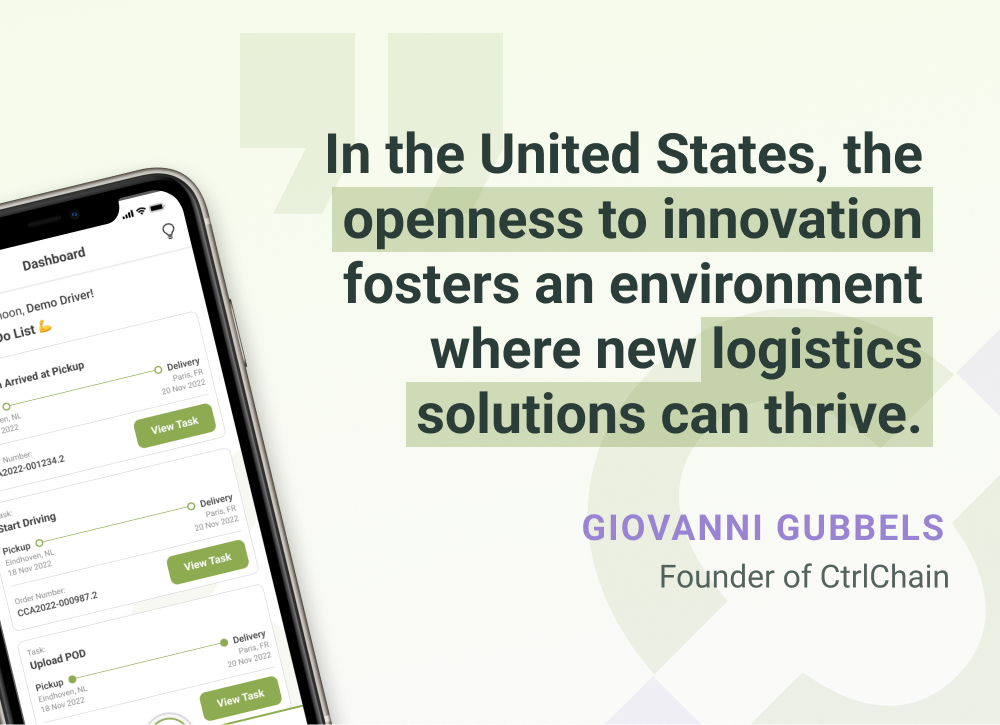
Chicago is situated in the heartland of America. As a result, it has become an important transportation and logistics hub. The city serves as a vital junction for the seamless movement of people and goods across various modes of transportation, including air, water, rail, and road. Moreover, if you look at the extensive network of highways and railways, Chicago offers an abundance of connections. It is possible to reach nearly half of the population within approximately two days, which makes it a strategically sound choice in our line of business.
The US market is undeniably dynamic. This brings fluctuations, where the balance of power and prevailing market conditions can shift back and forth between a carrier and shipper market. I think it’s also important to highlight the greater openness to innovation exhibited by both carriers and shippers in the United States. It is an environment that embraces and welcomes new ideas and solutions. This mindset fosters a quickly evolving environment where new logistics solutions like ours can thrive.
On the other hand, the extent to which our software tool can provide solutions across various departments and ensure visibility within companies is quite similar to Europe. That’s because most organisations operate in silos. They may have different departments with different goals and needs that collaboratively support the end goal. However, they all rely on the same data. By offering a standalone solution that makes the necessary information readily available on a daily basis, we strive to bridge this gap and provide a comprehensive solution that meets their needs.
That being said, Chicago alone will not be enough if we want to really fulfil the entire market. So, we are actively exploring other locations that would enable us to achieve a more balanced geographical presence or be closer to our customers and carriers.
How do you see the market you are operating in developing over time? Will there still be space for niche players as the market matures?
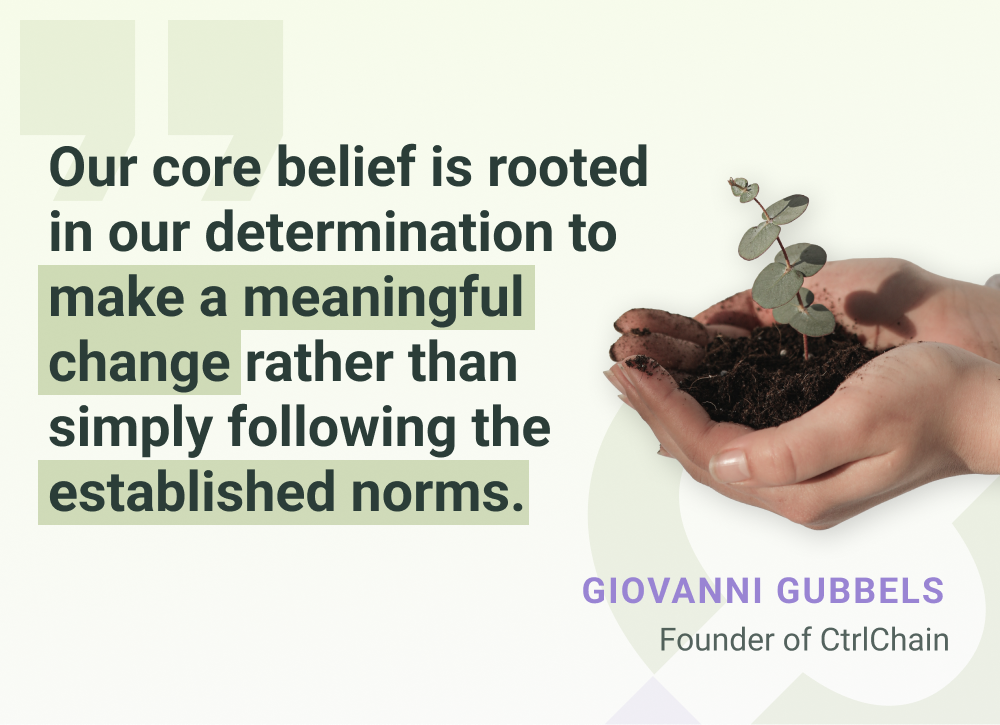
I don’t believe it’s a winner takes all market. There’s an abundance of volumes and many carrier companies, each with its own unique preferences. On the other hand, there are diverse modes of operation on the shipper side. So, there will always be niche requirements and specialised needs.
The key lies in fostering collaboration. If we, as logistics players, can make a significant impact in reducing our ecological footprints, we will achieve success collectively. If we can form partnerships with other companies and lawfully share our data, not only will it benefit our clients and us, but it will also contribute positively to society as a whole.
I strongly believe that adopting a collaborative mindset yields greater rewards than a desire to be the king of the mountain managing everything. Our core belief is rooted in our determination to make a difference and instigate meaningful change rather than simply following the established norms.
I have to admit some shippers and carriers prioritise obtaining the best prices and maintaining complete control, and that is perfectly fine. However, it doesn’t align with our approach and philosophy, hence it just isn't a match for us.
The market is large enough to accommodate several bigger players with their own goals as well as others who are a better collaborative fit. So, our focus lies in identifying what aligns with our values and where we can make the most significant impact, all while ensuring our operations remain sustainable.
There have been calls for widespread data sharing to unlock efficiencies across the supply chain. However, can this still be brought about when some entities may feel it’s in their own self-interest not to allow other parties to see their data?
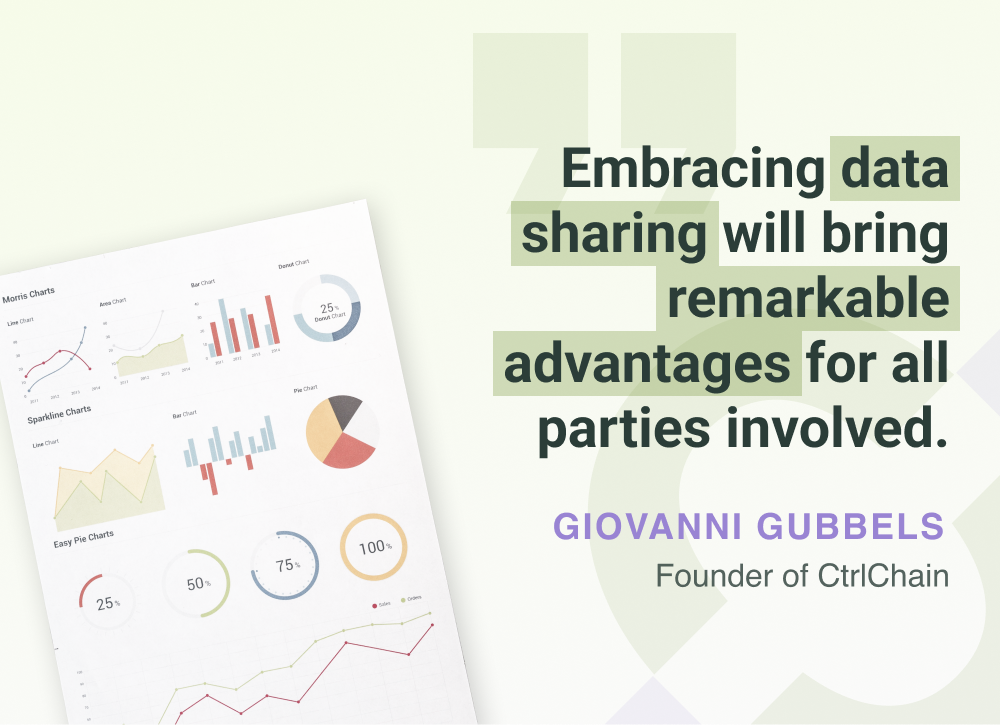
It has been really challenging. There have been times when fear seemed to govern decision-making, and companies were understandably cautious about sharing sensitive data, fearing potential risks to customer information and other confidential aspects.
So, if we don't take the initiative to educate stakeholders about the significant benefits that certain data-sharing practices can bring, we'll find ourselves stuck in a cycle of reluctance. We must change this mindset because embracing data sharing will bring remarkable advantages for all parties involved. It's crucial that we emphasise the value of collaboration and the positive impact it can have on our collective success.
Stakeholder management is extremely important within companies. It's not always easy to gain alignment, especially when navigating complex internal dynamics, let alone externally. It requires time, patience, and consistent effort to foster understanding and drive progress in the right direction.
Moreover, we should start exploring data-sharing initiatives in academic institutions if we truly aspire to drive meaningful change. We need to adapt quicker to the demands of our evolving landscape. We must be agile, continuously learn from our own experiences, and also be open to learning from one another. Otherwise, we will not survive.
There is notable resistance to change within the logistics industry, which is also why we are far behind other markets. So, teaching the importance of embracing change and highlighting how it can positively impact companies will pave the way to enhanced efficiency, innovation, and collaboration. This is where it's possible to differentiate and stand out from the crowd compared to older competitors.
If we talk about digital platforms, it's all about making it easier and quicker to do a specific task. Yet, it's important to note that simply implementing digital solutions doesn't automatically convey an understanding of their actual value and potential benefits.
There’s been talk of Investor attitudes changing since the economic downturn last autumn. What have you seen, and have you changed the way you do things as a result?
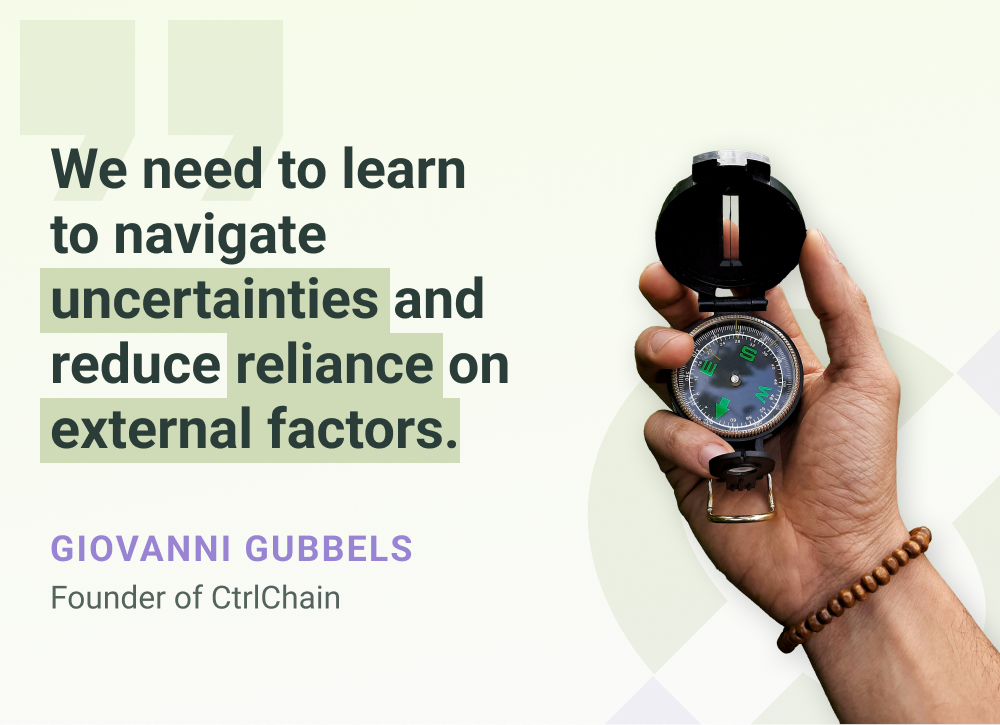
Talking about the fascinating period we’ve experienced over the past few years, where the investment landscape seemed like a beautiful bubble. Investors had a different mindset then – money was flowing abundantly, and the primary goal was to deploy it as quickly as possible. As long as there was potential and a company showed incremental monthly growth, profitability was less important in the dynamic high-tech sector. It was a time when companies could focus on scaling and expanding without immediate financial concerns.
However, times have changed, and the focus has shifted towards profitability. Investors want to understand the roadmap and avoid pouring in money all the time. That definitely is a significant change and not necessarily a bad one. As a result, you see business leaders making strategic changes, quitting, or even falling by the wayside. This is a trend that will accelerate.
We have always invested heavily in technology and innovation, and we remain committed to that path. So, for us, the core focus remains the same. The only thing is that we are more focused on the near future. We now have a more near-term outlook, ensuring that we can navigate uncertainties and reduce our reliance on external factors. We want to depend less on external factors and ensure our stability even in challenging times.
Some predict that digitalisation in logistics is moving towards an all-in-one solution whereby customers can get the benefit of things like control towers, visibility platforms, TMSs, WMSs and more in one place. Others don’t see it that way as they believe some businesses will always seek the best in class if it is available. How do you see this situation going forward?
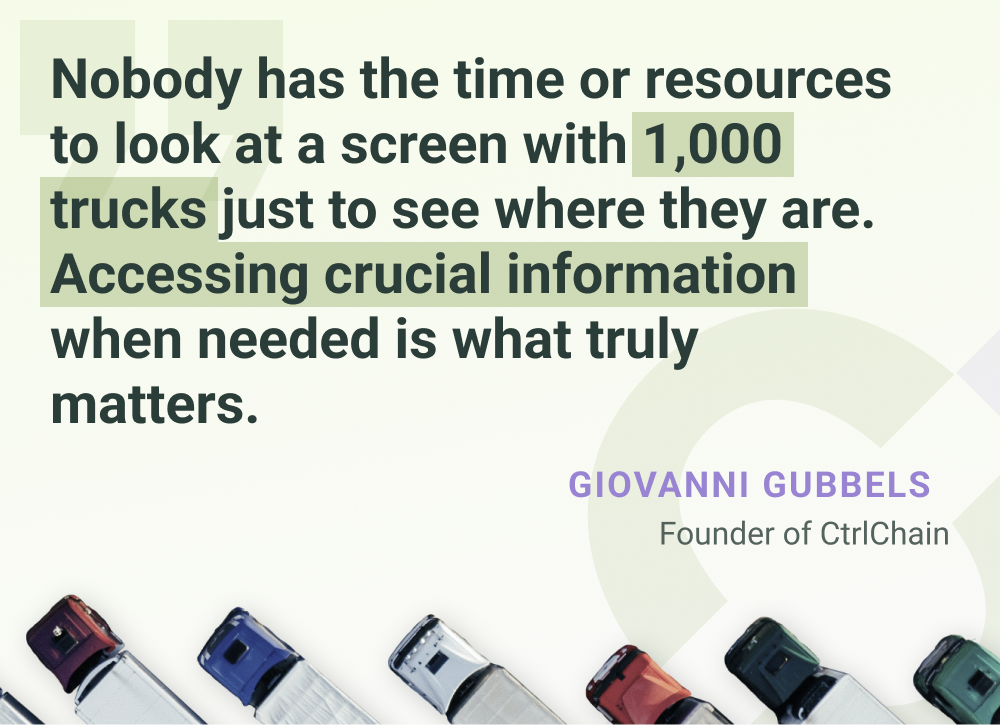
Some predict that digitalisation in logistics is moving towards an all-in-one solution whereby customers can get the benefit of things like control towers, visibility platforms, TMSs, WMSs and more in one place. Others don’t see it that way as they believe some businesses will always seek the best in class if it is available. How do you see this situation going forward?
I firmly believe in the power of expertise. Having specific know-how in a particular domain can give you a competitive edge over others. However, it all comes down to understanding the specific needs you want to solve and the desired outcomes you aim to achieve.
While having visibility is important, let’s be realistic – nobody has the time or resources to look at a screen with 1,000 trucks just to see where they are. What truly matters is having access to crucial information exactly when it’s needed, triggered by specific events. However, the challenge lies in the fact that by the time an event is triggered, it may already be too late, as you’re essentially reacting to past events based on the data you’re observing.
Suppose you only receive visibility a few hours before a scheduled pickup. In that case, you’re left with limited time to determine whether making the necessary arrangements is feasible or not. On the other hand, if you know a specific truck’s planning, you can avoid missed pickups by simply choosing alternative offers. Meanwhile, the truck that lost the job can easily secure another load that aligns with its pickup schedule. Not to mention that by leveraging real-time data, we can effectively predict and address issues like penalties for on-time performance and customer experience.
However, we can only tackle the utilisation problem by starting at the source of planning, which resides within the carrier company itself and its telematics planning systems. To transition from pre-planned planning to dynamic planning and optimise truck utilisation, we need to have accurate information on the location and planned activities of each truck before allocating a shipment to them.
In conclusion, to truly progress, CtrlChain must explore dynamic solutions that deliver real-time data to users when they need it. This involves harnessing the power of machine learning and artificial intelligence and obtaining information from the right sources, whether built in-house or acquired from market experts such as TMS, GPS providers, or telematics providers. The key lies in making informed decisions about integration, data sharing, and collaboration, enabling CtrlChain to meet its own needs and contribute to flattening the climate curve.

.png?width=550&height=290&name=featured%20image-big%20(41).png)

